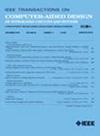Prerouting Timing Prediction Across Different Technology Nodes
IF 2.7
3区 计算机科学
Q2 COMPUTER SCIENCE, HARDWARE & ARCHITECTURE
IEEE Transactions on Computer-Aided Design of Integrated Circuits and Systems
Pub Date : 2024-12-27
DOI:10.1109/TCAD.2024.3523426
引用次数: 0
Abstract
In the domain of very-large-scale integration (VLSI) design, the accuracy of prerouting timing prediction is of paramount importance for ensuring the performance and reliability of integrated circuits. Traditional methods based on machine learning necessitate the availability of extensive and high-quality datasets. However, this requirement poses significant challenges for advanced technology nodes due to the laborious and time-intensive nature of data preparation. To address this critical issue, we introduce a novel transfer learning framework that leverages data from preceding technology nodes to facilitate learning and prediction on the target node. Our methodology commences with the disentanglement and alignment of timing path features across different nodes, ensuring the preservation and effective translation of intrinsic timing path properties. Subsequently, we employ a Bayesian-based model to predict the arrival times of individual timing paths. This model is particularly adept at managing the high-variability inherent in arrival times and exhibits strong generalization capabilities to novel design scenarios. Moreover, we propose a new algorithm to reweight the preceding node data during training by estimating their transferability through the cell type distribution. We validate the efficacy of our proposed framework through comprehensive experimental evaluations, demonstrating successful transfer learning from 130 or 45 to 7-nm technology nodes. The results underscore the potential of our approach to significantly mitigate the dependency on extensive data preparation while maintaining high accuracy in timing prediction for cutting-edge VLSI designs.跨不同技术节点的预路由时间预测
在超大规模集成电路(VLSI)设计领域,预布线时间预测的准确性对于保证集成电路的性能和可靠性至关重要。基于机器学习的传统方法需要大量高质量的数据集。然而,由于数据准备工作的费力性和耗时性,这一要求对先进技术节点构成了重大挑战。为了解决这一关键问题,我们引入了一种新的迁移学习框架,该框架利用来自先前技术节点的数据来促进目标节点的学习和预测。我们的方法从跨不同节点的时序路径特征的解纠缠和对齐开始,确保了固有时序路径属性的保存和有效转换。随后,我们采用基于贝叶斯的模型来预测各个定时路径的到达时间。该模型特别擅长管理到达时间固有的高可变性,并表现出对新设计场景的强大泛化能力。此外,我们还提出了一种新的算法,通过单元格类型分布来估计节点数据的可转移性,从而在训练过程中对前面的节点数据进行重加权。我们通过全面的实验评估验证了我们提出的框架的有效性,证明了从130或45到7纳米技术节点的成功迁移学习。结果强调了我们的方法的潜力,可以显着减轻对大量数据准备的依赖,同时保持尖端VLSI设计的高精度时序预测。
本文章由计算机程序翻译,如有差异,请以英文原文为准。
求助全文
约1分钟内获得全文
求助全文
来源期刊
CiteScore
5.60
自引率
13.80%
发文量
500
审稿时长
7 months
期刊介绍:
The purpose of this Transactions is to publish papers of interest to individuals in the area of computer-aided design of integrated circuits and systems composed of analog, digital, mixed-signal, optical, or microwave components. The aids include methods, models, algorithms, and man-machine interfaces for system-level, physical and logical design including: planning, synthesis, partitioning, modeling, simulation, layout, verification, testing, hardware-software co-design and documentation of integrated circuit and system designs of all complexities. Design tools and techniques for evaluating and designing integrated circuits and systems for metrics such as performance, power, reliability, testability, and security are a focus.

 求助内容:
求助内容: 应助结果提醒方式:
应助结果提醒方式:


